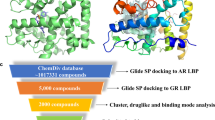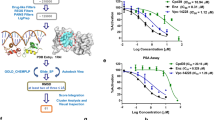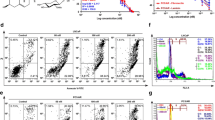Abstract
R-bicalutamide, a first generation antiandrogen, was used to treat prostate cancer for decades. Although it is very effective at the beginning, resistance appears after 2–3 years of treatment. Mutation of androgen receptor (AR) is considered a main reason for drug resistance. It is reported that AR W741C, W741L, W741C_T877A, T877A, F876L, F876L_T877A and L701H mutations can convert R-bicalutamide from AR antagonist to agonist, but the switching mechanisms are not clear. In this study, molecular dynamics simulations and molecular mechanics generalized Born surface area (MM-GBSA) calculations were performed to analyze the interaction mechanisms between R-bicalutamide and wild type/mutant ARs. The results indicate that helix H12, which lies on the top of AR LBD like a cover, plays a vital role in R-bicalutamide binding. When interacting with AR, the B-ring of R-bicalutamide pushes H12 aside, distorting the coactivator binding site (AF2) resulting in the inactivation of transcription. Several residue mutations appear to enlarge the distance between the B-ring of R-bicalutamide and H12, reducing steric clash, which is conducive to a closed H12 conformation, leading to the formation of the coactivator binding site AF2 and increased transcription. Hydrogen bond and per-residue free energy decomposition analyses are also investigated to explore the interacting mechanisms, and M895 is found to be a key residue in the antagonist mechanism. The obtained molecular mechanisms will aid rational screening and design of novel AR antagonists, even to mutant AR.






Similar content being viewed by others
References
Center MM, Jemal A, Lortet-Tieulent J, Ward E, Ferlay J, Brawley O, Bray F (2012) International variation in prostate cancer incidence and mortality rates. Eur Urol 61:1079–1092
Siegel RL, Miller KD, Jemal A (2015) Cancer statistics. CA Cancer J Clin 65:5–29
DeSantis CE, Lin CC, Mariotto AB, Siegel RL, Stein KD, Kramer JL, Alteri R, Robbins AS (2014) Cancer treatment and survivorship statistics, 2014. CA Cancer J Clin 64:252–271
Balk SP (2002) Androgen receptor as a target in androgen-independent prostate cancer. Urology 60:132–138
Gao W, Bohl CE, Dalton JT (2005) Chemistry and structural biology of androgen receptor. Chem Rev 105:3352–3370
Mohler ML, Bohl CE, Jones A, Coss CC, Narayanan R, He Y, Hwang DJ, Dalton JT, Miller DD (2009) Nonsteroidal selective androgen receptor modulators (SARMs): dissociating the anabolic and androgenic activities of the androgen receptor for therapeutic benefit. J Med Chem 52:3597–3617
Narayanan R, Mohler ML, Bohl CE, Miller DD, Dalton JT (2008) Selective androgen receptor modulators in preclinical and clinical development. Nucl Recept Siqnal 6:e010
Zhou XE, Suino-Powell KM, Li J, He YZ, MacKeigan JP, Melcher K, Yong EL, Xu HE (2010) Identification of SRC3/AIB1 as a preferred coactivator for hormone-activated androgen receptor. J Biol Chem 285:9161–9171
Crawford ED, DeAntoni EP (1995) Current status of combined androgen blockade: optimal therapy for advanced prostate cancer. J Clin Endocrinol Metab 80:1062–1066
Miyamoto H, Messing EM, Chang C (2004) Androgen deprivation therapy for prostate cancer: current status and future prospects. Prostate 61:332–353
Mukherjee A, Kirkovsky L, Yao XT, Yates RC, Miller DD, Dalton JT (1996) Enantisoselective bindingof Casodex to the addrogen receptor. Xenobiotica 26:117–122
Dalesio O, Tinteren H, Clarke M, Peto R, HSchröder F (2000) Maximum androgen blockade in advanced prostate cancer: an overview of the randomised trials Prostate Cancer Trialists’ Collaborative Group. Lancet 355:1491–1498
Petrylak DP (1999) Chemotherapy for advanced hormone refractory prostate cancer. Urology 54:30–35
Taplin ME, Bubley GJ, Ko YJ, Small EJ, Upton M, Rajeshkumar B, Balk SP (1999) Selection for androgen receptor mutations in prostate cancers treated with androgen antagonist. Cancer Res 59:2511–2515
Hara T, Miyazaki J, Araki H, Yamaoka M, Kanzaki N, Kusaka M, Miyamoto M (2003) Novel mutations of androgen receptor: a possible mechanism of bicalutamide withdrawal syndrome. Cancer Res 63:149–153
Taplin ME, Bubley GJ, Shuster TD, Frantz ME, Spooner AE, Ogata GK, Keer HN, Balk SP (1995) Mutation of the androgen-receptor gene in metastatic androgen-independent prostate cancer. N Engl J Med 332:1393–1398
Marcelli M, Ittmann M, Mariani S, Sutherland R, Nigam R, Murthy L, Zhao Y, Concini DD, Puxeddu E, Esen A, Eastham J, Weigel NL, Lamb DJ (2000) Androgen receptor mutations in prostate cancer. Cancer Res 60:944–949
Liu HL, An XL, Li SY, Wang YW, Li JZ, Liu HX (2015) Interaction mechanism exploration of R-bicalutamide/S-1 with WT/W741L AR using molecular dynamics simulations. Mol Biosys 11:3347–3354
Balbas MD, Evans MJ, Hosfield DJ, Wongvipt J, Arora VK, Watson PA, Chen Y, Greene LG, Shen Y, Sawyers CL (2013) Overcoming mutation-based resistance to antiandrogens with rational drug design. Elife 2:e00499
Korpal M, Korn JM, Rakiec DP, Ruddy DA, Dashi S, Yuan J, Kovats SG, Kim S, Cooke VG, Monahan JE, Stegmeier F, Roberts TM, Sellers WR, Zhou W, Zhu P (2013) An F876L mutation in androgen receptor confers genetic and phenotypic resistance to MDV3100 (enzalutamide). Cancer Discov 3:1030–1043
van de Wijingaart D, Molier M, Lusher SJ, Hersmus R, Jenster G, Trapman J, Dubbink HJ (2010) Systematic structure-function analysis of androgen receptor Leu701 mutants explains the properties of the prostate cancer mutant L701H. J Biol Chem 285:5097–5105
Duan M, Liu N, Zhou W, Li D, Yang M, Hou T (2016) Structural diversity of ligand-binding androgen receptors revealed by microsecond long molecular dynamics simulations and enhanced sampling. J Chem Therory Comput 12:4611–4619
RCSB Protein Data Bank. http://www.rcsb.org/pdb
Discovery Studio version 2.5 (2009) Accelrys Inc. CA
Guex N, Peitsch MC (1997) SWISS-MODEL and the Swiss-PdbViewer: an environment for comparative protein modeling. Electrophoresis 18:2714–2723
Tripos (1999) Sybyl 6.9; Tripos Associates, Inc.: St. Louis
Cieplak P, Cornell WD, Bayly C, AKollman P (1995) Application of the multimolecule and multiconformational RESP methodology to biopolymers: charge derivation for DNA, RNA, and proteins. J Comput Chem 16:1357–1377
Fox T, Kollman PA (1998) Application of the RESP Methodology in the Parametrization of Organic Solvents. J Phys Chem B 102:8070–8079
Bayly CI, Cieplak P, Cornell WD, Kollman PA (1993) A well-behaved electrostatic potential based method using charge restraints for deriving atomic charges—the RESP model. J Phys Chem B 97:10269–10280
Frisch MJ, Trucks GW, Schlegel HB, Scuseria GE, Robb MA, Cheeseman JR, Scalmani G, Barone V, Mennucci B, Petersson GA, Nakatsuji H, Caricato M, Li X, Hratchian HP, Izmaylov AF, Bloino J, Zheng G, Sonnenberg JL, Hada M, Ehara M, Toyota K, Fukuda R, Hasegawa J, Ishida M, Nakajima T, Honda Y, Kitao O, Nakai H, Vreven T, Montgomery JA, Peralta JE, Ogliaro F, Bearpark M, Heyd JJ, Brothers E, Kudin KN, Staroverov VN, Kobayashi R, Normand J, Raghavachari K, Rendell A, Burant JC, Iyengar SS, Tomasi J, Cossi M, Rega N, Millam NJ, Klene M, Knox JE, Cross JB, Bakken V, Adamo C, Jaramillo J, Gomperts R, Stratmann RE, Yazyev O, Austin AJ, Cammi R, Pomeli C, Ochterski JW, Martin RL, Morokuma K, Zakrzewski VG, Voth GA, Salvador P, Dannenberg JJ, Dapprich S, Danies AD, Farkas Ö, Foresman JB, Ortiz JV, Cioslowski J, Fox DJ (2009) Gaussian 09. Gaussian Inc, Wallingford, CT
Case DA, Darden TA, Cheatham TE, Simmerling CL, Wang J, Duke RE, Luo R, Walker RC, Zhang W, Merz KM, Roberts B, Hayik S, Roitberg A, Seabra G, Swails J, Götz AW, Kolossváry I, Wong KF, Paesani F, Vanicek J, Wolf RM, Liu J, Wu X, Brozell SR, Steinbrecher T, Gohlke H, Cai Q, Ye X, Wang J, Hsieh MJ, Cui G, Roe DR, Mathews DH, Seetin MG, Salomon-Ferrer R, Sagui C, Babin V, Luchko T, Gusarov S, Kovalenko A, Kollman PA (2012) AMBER 12. University of California, San Francisco
Wang J, Wolf RM, Caldwell JW, Kollman PA, Case DA (2004) Development and testing of a general amber force field. J Comput Chem 25:1157–1174
Hornak V, Abel R, Okur A, Strockbine B, Roitberg A, Simmerling C (2006) Comparison of multiple Amber force fields and development of improved protein backbone parameters. Proteins 65:712–725
Jorgensen WL, Chandrasekhar J, Madura JD, Impey RW, Klein ML (1983) The origin of layer structure artifacts in simulations of liquid water. J Chem Phys 79:926–935
Ryckaert JP, Ciccotti G, Berendsen HJC (1977) Numerical integration of Cartesian equations of motion of a system with constraints: molecular dynamics of n-alkanes. J Comput Phys 23:327–341
Eaamann U, Perera L, Berkowitz ML, Darden T, Lee H, Pedersen LG (1995) Properties of organic liquids when simulated with long-range Lennard-Jones Interactions. J Chem Phys 103:8577–8593
Darden T, York D, Pedersen L (1993) Particle mesh Ewald: an NLog(N) method for Ewald sums in large systems. J Chem Phys 98:10089–10092
Hou TJ, Wang JM, Li YY, Wang W (2011) Assessing the performance of the MM/PBSA and MM/GBSA methods. 1. The accuracy of binding free energy calculations based on molecular dynamics simulations. J Chem Inf Model 51:69–82
Hou TJ, Wang JM, Li YY, Wang W (2011) Assessing the performance of the molecular mechanics/Poisson Boltzmann surface area and molecular mechanics/generalized Born surface area methods II. The accuracy of ranking poses generated from docking. J Comput Chem 32:866–877
Xu L, Sun HY, Li YY, Wang JM, Hou TJ (2013) Assessing the performance of MM/PBSA and MM/GBSA methods 3 The impact of force fields and ligand charge models. J Phys Chem B 117:8408–8421
Sun H, Li Y, Shen M, Tian S, Xu L, Pan P, Guan Y, Hou T (2014) Assessing the performance of MM/PBSA and MM/GBSA methods. 5. Improved docking performance using high solute dielectric constant MM/GBSA and MM/PBSA rescoring. Phys Chem Chem Phys 16:22035–22045
Sun H, Li Y, Tian S, Xu L, Hou T (2014) Assessing the performance of MM/PBSA and MM/GBSA methods. 4. Accuracies of MM/PBSA and MM/GBSA methodologies evaluates by various simulation protocols using PDBbind data set. Phys Chem Chem Phys 16:16719–16729
Chen F, Liu H, Sun H, Pan P, Li Y, Li DD, Hou T (2016) Assessing the performance of the MM/PBSA and MM/GBSA methods. 6. Capability to predict protein-protein binding free energies and re-rank binding poses generated by protein-protein docking. Phys Chem Chem Phys 18:22129–22139
Hou T, Li N, Li Y, Wang W (2012) Characterization of domain–peptide interaction interface: prediction of SH3 domain-mediated protein–protein interaction network in yeast by generic structure-based models. J Proteome Res 11:2982–2985
Onufriev A, Bashford D, Case DA (2004) Exploring protein native states and large-scale conformational changes with a modified generalized born model. Proteins 55:383–394
Kollman PA, Massova I, Reyes C, Kuhn B, Huo S, Chong L, Lee M, Duan Y, Wang W, Donini O, Cieplak P, Srinivasan J, Case DA, Cheatham TE (2000) Calculating structures and free energies of complex molecules: combining molecular mechanics and continuum models. Acc Chem Res 33:889–897
Sitkoff D, Sharp KA, Honig B (1994) Accurate calculation of hydration free energies using macroscopic solvent models. J Phys Chem 98:1978–1988
Yang Y, Shen YL, Liu HX, Yao XJ (2011) Molecular dynamics simulation and free energy calculation studies of the binding mechanism of allosteric inhibitors with p38α MAP kinase. J Chem Inf Model 51:3235–3246
Acknowledgements
This research is sponsored by Fundamental Research Funds for the Central Universities (lzujbky-2015-310 and lzujbky-2016-148).
Author information
Authors and Affiliations
Corresponding author
Rights and permissions
About this article
Cite this article
Liu, H., Han, R., Li, J. et al. Molecular mechanism of R-bicalutamide switching from androgen receptor antagonist to agonist induced by amino acid mutations using molecular dynamics simulations and free energy calculation. J Comput Aided Mol Des 30, 1189–1200 (2016). https://doi.org/10.1007/s10822-016-9992-2
Received:
Accepted:
Published:
Issue Date:
DOI: https://doi.org/10.1007/s10822-016-9992-2




